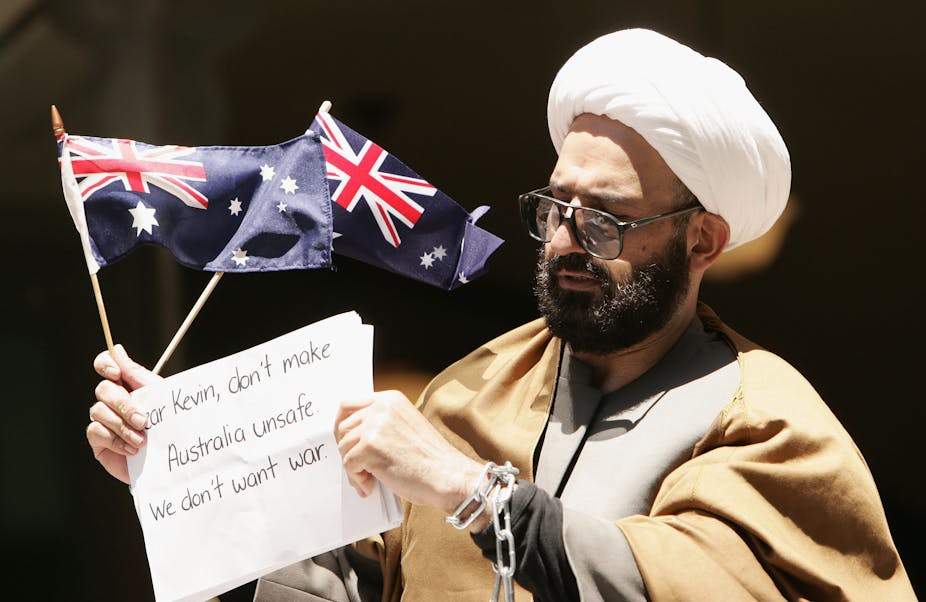The events of the Sydney siege this week evolved amid a torrent of speculation and theorising about the motivations and intent of the hostage-taker Man Haron Monis. Some media reporting during the Sydney siege even sought to compare the incident to America’s 9/11 and the London bombings in 2005.
The fact Monis forced his hostages to raise the flag bearing the Islamic testimony of faith certainly suggested that he may have been a radicalised violent extremist acting with a political or ideological motive.
The process of radicalisation
Violent extremism describes a situation in which the extreme belief in a social, political or ideological cause is coupled with a belief that violence is necessary and justified as a means to further that cause. Very few extremists actually become radicalised to the operational phase where they carry out acts of violence – but those that do can perpetrate horrendous crimes in the name of their adopted cause.
Terrorism is a form of violent extremism. Although there is no universally agreed upon definition of terrorism, most definitions include elements of violence or the threat of violence carried out for the purpose of spreading fear (or terror) and coercing governments and societies.

There is still much we do not know about the exact nature of radicalisation to violent extremism. That is because there is no singular profile to explain who becomes a violent extremist and why. Most theories or models of radicalisation concur that it is a process, not necessarily linear, by which an individual progresses through a mild interest in a political, social or ideological cause to accepting the use of violence as a valid means of furthering that cause.
The factors that result in radicalisation are complex and varied. They include individual psychology, personal and group identity, demographics, individual circumstances and contact with radicalising settings or influences, including personal contact with recruiters or influential people.
What about the internet?
Research suggests that the internet plays some role in radicalisation though assumptions about the role of the internet in self radicalising individuals are overstated. Empirical evidence supports the assumption that the internet creates more opportunities to become radicalised and serves as a space for individuals to find support for their ideas among like-minded individuals.
But there is no support for the assumption that the internet accelerates radicalisation and promotes self-radicalisation without physical contact.
Research has also shown that theories and assumptions about radicalisation are not supported in many cases of violent extremism. The marginalisation hypothesis that argues that radicalisation is a result of individual frustration and alienation does not explain why some who have travelled to fight alongside the so-called Islamic State come from well-adjusted family backgrounds and were well integrated in the broader community.
Contrary to popular belief, ideology and religion play a less important role in radicalisation. Current research by the Countering Online Violent Extremism Research Program at Curtin University, with which I am involved, indicates that the emotional appeal to personal identity and group solidarity are far more significant factors in radicalisation.
The ‘lone wolf’ theory
Even with the growing body of empirical research contributing to understanding radicalisation, cases such as that of Man Haron Monis raise questions about whether individual actors, known as “lone wolves”, are terrorists, violent extremists, radicals or simply lone gun men.
We normally associate terrorism with large-scale or mass casualty attacks such as 9/11 and the Bali bombings in 2002 – attacks of the sort that require significant planning, resourcing and coordination – often transnational.
But the strategy of leaderless or single-actor terrorism dates back to the 19th century anarchists who carried out political assassinations and bombings. In the 1980s and 1990s the strategy of using single individuals to perpetrate attacks was adopted by the white supremacist movement in the United States as a way of thwarting government crackdowns on their activities.
In fact, the term “lone wolfism” was introduced by Tom Metzger, a white supremacist.

Over the past few years lone-actor attacks have become more and more prevalent. Lone wolves are individuals who commit acts of violence in support of a group, though they may have no formal links to that group. Examples include Canadian Michael Zehaf-Bibeau, Anders Breivik in Norway and Mohammed Merah in France.
Each case is unique but all share the hallmarks of the lone actor. Breivik demonstrated extreme right-wing political views and wrote a 1500-page manifesto rationalising his attacks and his extremist ideology. Michael Zehaf-Bibeau, who shot a Canadian soldier earlier this year, had his passport cancelled and was suspected of planning to travel to abroad as a foreign fighter.
French gunman Mohammed Merah, who killed seven people in a shooting spree in France in 2012, claimed to be an associate of Al Qaeda. In each of these cases, including that of Monis, ideology or politics certainly appear to be the motivating force behind the violence, suggesting the actors were radicalised.
But there are also other factors to consider when distinguishing lone-wolf terrorist acts from similar attacks with no apparent motivation other than the actors own mental capacity or tendency for violence. Both Bibeau and Monis had criminal records and a history of violent behaviour.
Reports on Bibeau describe his behaviour before the attack as disturbing. Monis also exhibited erratic behaviour and could possibly have had a mental illness.
Official reports on Brievik indicated that he developed paranoid schizophrenia. Like Monis, Brievik exhibited high levels of narcissism and grandiose delusions.
What these cases tell us is that, unlike the strategic model of terrorism as a rational choice to carry out acts of violence in the name of a cause, these modern-day lone-wolf terrorists may be more like lone gunmen than terrorists.

